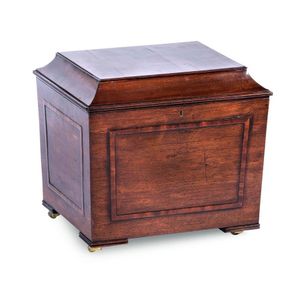Elizabethan Oak Coffer with Inlaid Motifs, c.1585
You must be a subscriber, and be logged in to view price and dealer details.
Subscribe Now to view actual auction price for this item
When you subscribe, you have the option of setting the currency in which to display prices to $Au, $US, $NZ or Stg.
- Oak - Native to Europe and England, oak has been used for joinery, furniture and building since the beginning of the medieval civilisation. It is a pale yellow in colour when freshly cut and darkens with age to a mid brown colour.
Oak as a furniture timber was superceded by walnut in the 17th century, and in the 18th century by mahogany,
Semi-fossilised bog oak is black in colour, and is found in peat bogs where the trees have fallen and been preserved from decay by the bog. It is used for jewellery and small carved trinkets.
Pollard oak is taken from an oak that has been regularly pollarded, that is the upper branches have been removed at the top of the trunk, result that new branches would appear, and over time the top would become ball-like. . When harvested and sawn, the timber displays a continuous surface of knotty circles. The timber was scarce and expensive and was used in more expensive pieces of furniture in the Regency and Victorian periods. - Fruitwood - A catch-all term used to describe the wood of any of several fruit-bearing trees, such as the apple, cherry, or pear, used especially in cabinetmaking.
With a blond colour when finished, fruitwood was used in Europe, especially France, in the 18th and 19th centuries for larger items of furniture such as tables, chairs, cabinets and bookcases but in England its use was generally restricted to decorative elements such as inlays. - Elizabethan - Strictly speaking, furniture usually in oak, made in the reign of Elizabetht I, from 1558 to 1603. The style incororates elaborate and ostentatious carving of classicial figures and themes and bulbous baluster legs, with an Italian Renaissance influence. When a piece is described as "Elizabethan style", it mimics the attributes of the Elizabethan period, but was made at a later date.
- Linenfold Carving - Linenfold carving is a carving style characterized by a pattern of vertical lines and curves that resemble folded linen or cloth. Linenfold carving was used primarily for the decoration of wood panels, which were often used for doors, furniture, and architectural elements such as wainscoting and panelling. The pattern was created by carving a series of shallow, parallel grooves into the wood, which were then smoothed and shaped to resemble folds of cloth.
- Inlay - Decorative patterns inserted into the main body of a piece of furniture, generally in wood of contrasting colour and grain, though brass, ivory, ebony, shell and sometimes horn have been used. Inlay may consist of a panel of well figured timber inset into a cabinet door front, geometric patterns, or complex and stylized designs of flowers, swags of foliage, fruits and other motifs. As a general rule, in pieces where the carcase is constructed in the solid, the inlay is relatively simple such as stringing, cross banding and herringbone banding. Where more elaborate and decorative work was required veneer was used. Inlay has been fashionable from at least the latter half of the 17th century, when a variety of elaborate forms were developed
This item has been included into following indexes:
Visually similar items

A Georgian mahogany cellarette, English, 19th century, 44 cm high, 49 cm wide, 40 cm deep

A fine walnut and specimen wood marquetry and parquetry commode, Northern Italian, circa 1770 with original enamelled and hexagonal handle detail. 82 cm high, 121 cm wide, 59 cm deep

A French Henri II oak twin pedestal writing desk, the top with inset leather and moulded edge above a front well carved with three nude woman in the midst of snakes, flanked by Corinthian pilasters, the reverse with knee hole flanked by drawers and panel d

An 18th century English oak coffer, three plain panels to the front. 91 x 46 x 53 cm
